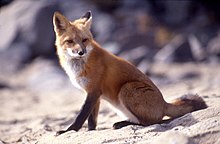Red fox
The red fox (Vulpes vulpes) is a mammal of the order Carnivora. It is the biggest and most well-known species of fox. Red foxes are sometimes hunted for sport, or killed as pests or carriers of rabies.[2]
| Red fox Temporal range:
Mid-Pleistocene–Recent | |
|---|---|

| |
| A red fox, photographed at the British Wildlife Centre Surrey | |
| Scientific classification | |
| Kingdom: | |
| Class: | |
| Order: | |
| Family: | |
| Tribe: | |
| Genus: | |
| Binomial name | |
| Vulpes vulpes (Linnaeus, 1758)
| |

| |
| Distribution of the red fox. Basically, they are all over the northern hemisphere | |



Description
changeRed foxes have long legs, pointed triangular black ears, a pointed snout, and a long bushy tail other red foxes The tail is also something of a food store.
Foxes also communicate with each other by urinating on trees or rocks, like dogs sometimes do. Its back, sides, and head are usually covered with reddish-brown fur, and its neck and chest are covered with white fur. The tail tip of a red fox is white. Its legs and paws are normally black.[3]
Hunting behavior, diet and predators
changeRed foxes hunt alone. Red foxes are omnivores. They feed on mice, squirrels, birds, rabbits, hares, and other small animals. However, they will also eat fruit, vegetables, fish, frogs, lizards, eggs, insects, and worms. The red fox will continue to hunt even when it is full.[3] It stores leftover food to eat later. When they are raised by humans domestically, they can also eat pet food. Red Foxes hunt mostly at night, sunset, and dawn.[4]
When prey has been detected, the fox crouches low to the ground and moves towards it, while attempting to minimize any noise or visual warnings. During the approach, the fox´s eyes remain on its prey. A chase starts once the fox has been seen. the prey escaping through dense bushes, or in the fox disabling it by biting it in the legs.
Red foxes have a few natural predators. Their predators are wolves, coyotes, bears, cougars, and lynxes, while eagles, hawks, owls, and badgers are predators of red fox kits, although eagles can kill adult foxes. Humans are the worst enemies of foxes as humans kill foxes for their fur.
Mating
changeRed foxes usually mate in the winter. The vixen (female fox) normally gives birth to a litter of 2 to 12 pups. When red foxes are born, they are brown or gray. Although a new red coat usually grows in one month, some red foxes have other colored coats such as golden, reddish-brown, silver, or even black. The mother of the pups, after she weens them, feeds them at first by regurgitating food into their mouths.[4]
Sleep
changeFoxes generally do not sleep in dens unless they are females who are giving birth to or raising cubs. Female foxes seek out dens made by other animals, like rabbits or badgers, but will dig their own den if necessary. Foxes in the wild curl up in a ball out in the open to sleep, keeping warm by covering themselves with their bushy tails. Foxes who live in urban areas may sleep under structures such as sheds.
Habitat
changeIt is native to America, Asia, and Europe. They were later brought to Australia.
Foxes in Australia
changeThere are about 1.7 million foxes in Australia. Early settlers brought red foxes to Australia in the 19th century, because they wanted to hunt the foxes as a sport. In the next 100 years, foxes spread across Australia and became an invasive species. Red foxes kill hundreds of millions of animals in Australia every year, which strongly hurts the continent's biodiversity.[5] Currently, there are efforts to reduce the fox population.[6]
References
change- ↑ Macdonald D.W. & Reynolds J.C. (2008). "Vulpes vulpes". IUCN Red List of Threatened Species. Version 2008. International Union for Conservation of Nature. Retrieved 2006-08-09.
- ↑ Terrance B. Adamson. "Red fox facts". National Geographic Society. Retrieved 2010-12-27.
- ↑ 3.0 3.1 Peter A. Frid. "The Red Fox". Durham, NH 03824: New Hampshire Public Television. Retrieved 2010-12-27.
{{cite web}}: CS1 maint: location (link) - ↑ 4.0 4.1 Mark Moran. "Studies of the red fox from the northern Virginia ecology". Fairfax County Public Schools. Archived from the original on 2017-08-10. Retrieved 2010-12-27.
- ↑ Stobo-Wilson, Alyson; Murphy, Brett; Dielenberg, Jaana; Woinarski, John; Legge, Sarah; Fleming, Trish. "1.7 million foxes, 300 million native animals killed every year: now we know the damage foxes wreak". The Conversation. Retrieved 2022-10-30.
- ↑ "European fox | Vulpes vulpes" (PDF). The State of Queensland, Department of Agriculture and Fisheries. Retrieved 2022-10-30.
Other websites
changehttp://animals.mom.me/foxes-sleep-7359.html
http://mynarskiforest.purrsia.com/ev6rhunt.htm
http://www.onekind.org/be_inspired/animals_a_z/fox_red/ Archived 2015-10-17 at the Wayback Machine
